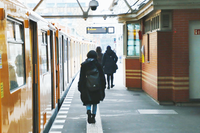Impulses for a healthy mobility transition
How healthy is active mobility in the city? When are cycling, walking etc. perceived as pleasant? How can new mobility routines be established in everyday life – and how can companies and civil society contribute to this? We present initial insights into these important questions for the mobility transition here.
Human health, climate change and the environment are closely intertwined. This connection is becoming particularly clear in the area of mobility. If it is possible to reduce car traffic in cities and bring more physical activity into everyday life, then health benefits on many levels: from air quality and stress reduction to a healthy urban climate.
“There's no such thing as the wrong weather, only the wrong clothes” – who hasn't heard this saying? The fact is, however, that the weather can influence which form of transportation people choose in cities. Getting out and about in the fresh air is fun – but it means being exposed to sun, rain, wind, and temperatures. And with climate change, weather extremes such as heavy rain and hot days are increasing.
Trying something new can can cost quite some effort, for example when you cycle to work for the first time: You may have misjudged the time required, not yet found the optimal route or forgotten your spare T-shirt. Routines such as grabbing your car or bike keys in the morning or the usual walk to the city train are deeply ingrained in everyday life. At the same time, they are linked to local conditions such as transport infrastructure. With AMBER, we are investigating how people experience their everyday journeys – while moving around as usual or trying to develop new mobility habits.
Civil society is the driving force behind the mobility transition in Germany. Organizations such as the ADFC hold numerous bike demonstrations every year, demanding the expansion of safe cycle paths, among other things. Thanks to the commitment of the “Initiative Volksentscheid Fahrrad (Initiative Bicycle Referendum)”, which was founded in 2016, the state of Berlin passed a mobility law in summer 2018 that includes the expansion of safe cycling infrastructure [1]. This example shows: Healthy, active mobility is not a private matter. In order for it to be accessible to everyone, infrastructure and laws must change, and this requires civil society participation.
Commuting to work or within the office accounts for almost 40 % of the traffic volume in Germany. In cities in particular, commuter traffic leads to traffic jams and creates a huge demand for parking spaces. Employers can facilitate active mobility with operational mobility management – for example with a business ticket for public transport and a bike-friendly corporate culture.




